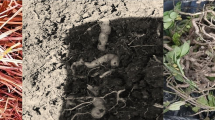Abstract
The postburn infections especially antibiotic-resistant bacterial infections have been recognized as a significant and major public health problem. Staphylococcus aureus, Escherichia coli, Acinetobacter, Klebsiella pneumoniae, and Pseudomonas aeruginosa are among very important bacterial pathogens isolated from postburn infections. The present study has evaluated the antimicrobial activity of some plant extracts (Melissa officinalis and Lawsonia inermis) against some bacterial pathogens causing burn wound infection. The minimal inhibitory concentration (MIC) and the minimal bactericidal concentration (MBC) of the extracts were determined using the microdilution method. Aqueous and alcoholic extracts of L. inermis leaves or powder and hydro-alcoholic extract of M. officinalis were studied. All extracts had the highest antibacterial activity against S. aureus. Although there was no significant difference between antibacterial activity of L. inermis leaves and powder extracts, significant difference was observed between alcoholic and aqueous extracts of this plant. In addition, the results showed that alcoholic extract of L. inermis powder and M. officinalis extracts showed synergistic effect. Overall, these findings support the potential benefits of M. officinalis and L. inermis extracts in the treatment of burn infections.





Similar content being viewed by others
References
Abdulmoneim Saadabi MA (2007) Evaluation of Lawsonia inermis Linn. (Sudanese Henna) leaf extracts as an antimicrobial agent. Res J Biol Sci 2(4):419–423
Al-Rubiay KK, Jaber NN, Al-Mhaawe BH, Alrubaiy NN (2008) Antimicrobial efficacy of henna extracts. Oman Med J 23(4):253–6
Bayram Y, Parlak M, Aypak C, Bayram I (2013) Three-year review of bacteriological profile and antibiogram of burn wound isolates in Van, Turkey. Int J Med Sci 10(1):19–23
Church D, Elsayed S, Reid O, Winston B, Lindsay R (2006) Burn wound infections. Clin Microbiol Rev 19(2):403–434
Elmam A, Rahimian J, Doymaz M (2010) In vitro evaluation of antibiotic synergy for polymyxin B-resistant carbapenemase-producing Klebsiella pneumoniae. J Clin Microbiol 48(10):3558–3562
French GL (2006) Bactericidal agents in the treatment of MRSA infections-the potential role of daptomycin. J Antimicrob Chemother 58(6):1107–17
Jothipraksam V, Ramesh S, Kumarn Rajasekharan S (2013) Preliminary phytochemical screening and antibacterial activity of Lawsonia inermis (henna) leaf extracts against reference bacterial strains and clinically important AMPC beta-lactamases producing Proteus mirabilis. Int J Pharm Pharm Sci 5(1):219–222
Kannani M, Vinotha K (2013) Antimicrobial activity of Lawsonia inermis leaf extracts against some human pathogens. Int J Cur Microbiol Appl Sci 2(5):342–349
Merdaw MA (2009) Inhibition of bacterial growth by Lawsonia inermis (henna) leaf extracts in vitro. Ibn Al-Haitham J Pure Appl Sci 22(4):32–38
Mimica-Dukic N, Bozin B, Sokovic M, Simin N (2004) Antimicrobial and antioxidant activities of Melissa officinalis L. (Lamiaceae) essential oil. J Agric Food Chem 52:2485–2489
Muhammad HS, Muhammad S (2005) The use of Lawsonia inermis Linn. (henna) in the management of burn wound infections. Afr J Biotechnol 4(9):934–937
Naghsh N, Doudi M, Nikbakht Z (2013) Investigation between alcoholic extract and essential oil Melissa officinalis L new in growth inhibition of E. coli. Zahedan J Res Med Sci 15(8):42–45
National Committee for Clinical Laboratory Standards (2007) Performance standards for antimicrobial disc susceptibility tests: approved standard NCCLS publication M2-A5. Clinical and Laboratory Standards Institute, Villanova, PA, USA
Raja W, Ovais M, Dubey A (2013) Phytochemical screening and antibacterial activity of Lawsonia inermis leaf extract. Int J Microbiol Res 4(1):33–36
Rastegar Lari AR, Alaghehbandan R, Akhlaghi L (2005) Burn wound infection and antimicrobial resistance in Tehran. Ann Burns Fire Disasters 2:68–73
Romero CD, Chopin SF, Buck G, Martinez E, Garcia M, Bixby L (2005) Antibacterial properties of common herbal remedies of the southwest. J Ethnopharmacol 99:253–257
Sharopov FS, Wink M, Khalifaev DR, Zhang H, Dosoky NS, Setzer WN (2013) Composition and bioactivity of the essential oil of Melissa officinalis L. growing wild in Tajikistan. Int J Trad Nat Med 2(2):86–96
Stanojevic´ D, Comic´ L, Stefanovic´ O, Solujic´ Sukdolak S, Solujic´ Sukdolak S (2010) In vitro synergistic antibacterial activity of Melissa officinalis L. and some preservatives. Span J Agric Res 8(1):109–115
White RL, Burgess DS, Manduru M, Bosso JA (1996) Comparison of three different in vitro methods of detecting synergy: time-kill, checkerboard, and E test. Antimicrob Agents Chemother 40(8):1914–1918
Acknowledgments
We thank the University of Isfahan for supporting this research.
Author information
Authors and Affiliations
Corresponding author
Rights and permissions
About this article
Cite this article
Rabbani, M., Etemadifar, Z., Karamifard, F. et al. Assessment of the antimicrobial activity of Melissa officinalis and Lawsonia inermis extracts against some bacterial pathogens. Comp Clin Pathol 25, 59–65 (2016). https://doi.org/10.1007/s00580-015-2140-x
Received:
Accepted:
Published:
Issue Date:
DOI: https://doi.org/10.1007/s00580-015-2140-x




